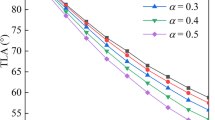Abstract
The mixed mode I/II SCC behavior of X-70 pipeline steel in the Xinjiang soil solution was investigated using single edge-notched specimens loaded in anti-symmetric and symmetric four-point bending configurations in laboratory. The results show that a maximum tensile stress criterion provides a good description for the mixed mode I/II SCC of X-70 pipeline steel in the near neutral pH solution, and the mixed mode TGSCC crack growth rate is larger than that of the mode I TGSCC. The magnitude increase of the crack growth rate decreases with the increase of the mode II loading.
Similar content being viewed by others
References
Zhang X Y, Lambert S B, Sutherby R, et al. Transgranular stress corrosion cracking of X-60 pipeline steel in simulated ground water. Corrosion, 1999, 55: 297–404
Beavers J A, Durr C L, Delanty B S, et al. Near-neutral pH SCC: Crack propagation in susceptible soil environments. Corrosion NACExpo 2001, NACE International, Houston, 2001. Paper No. 01217
Harle B A, Beavers J A, Jaske C E. Mechanical and metallurgical effects on low-pH stress corrosion cracking of natural gas pipelines. Corrosion 95 NACE, Orlando, 1995. Paper No. 646
Wilmott M J, Sutherby R L. The role of pressure and pressure fluctuations in the growth of stress corrosion cracks in line pipe steels. In: International Pipeline Conference, ASME, 1998. 409–422
Gao H, Xue L J. (I+II) mixed mode hydrogen induced cracking (in Chinese). Acta Metall Sin, 1989, 25: A48–A52
Gao H, Cao W J. Hydrogen assisted cracking of 30CrMnSiA steel under continuously hydrogen charging and (I+II) mixed mode loading condition (in Chinese). J Chin Soc Corros Protect, 1991, 11: 163–168
John C St, Gerberich W W. The Effect of loading mode on hydrogen embrittlement. Metall Trans, 1973, 4: 589–594
John C F St. Effect on crack loading mode on stress-corrosion cracking. Scripta Metall, 1975, 9: 141–144
Pickens J R, Gordon J R, Green J A S. The effect of loading mode on the stress-corrosion cracking of aluminum alloy 5038. Metall Trans, 1983, 14A: 925–930
Nichols F A. Loading mode and stress corrosion cracking mechanisms. Corrosion, 1983, 39: 449–451
McGuimm K F, Aballe M. Hydrogen embrittlement in mode II. Brit Corros J, 1982, 17: 18–20
Gao H, Wang Z, Yang C, et al. An investigation on the brittle fracture of KI-KII composite mode cracks (in Chinese). Acta Metall Sin, 1979, 15: 380–391
Maccagno T M, Knott J F. The fracture behavior of PMMA in mixed mode I and II. Eng Fract Mech, 1989, 34: 65–86
Erdogan F, Sih G C. On the crack extension in plates under plane loading and transverse shear. J Basic Eng, 1963, 85: 519–527
Sinclair I, Gregson P J. Mixed mode fatigue crack growth in the commercial Al-Li alloy 8090. Scripta Metall Mater, 1994, 30: 1287–1292
Gao H, Cao W J, Zhou D Q, et al. Mixed mode SCC of 18-8 stainless steel in 42% MgCl2 solution. Acta Metall Sin, 1991, 27: B320–B325
Gao H, Zhang X D. Study on the plastic zone ahead of mixed-mode crack tip fratured under linear elastic conditions. Acta Metall Sin, 1981, 17: 73–82
Gao H, Cao W J, Fang C P, et al. Distribution of hydrogen at the I+II mixed mode crack tip (in Chinese). J Chin Soc Corros Protect, 1993, 13: 237–243
Fang B Y, Han E H, Wang J Q, et al. Hydrogen in stress corrosion cracking of X-70 pipeline steels in near-neutral pH solutions. J Mater Sci, 2006, 41: 1797–1803
Author information
Authors and Affiliations
Corresponding author
Additional information
Supported by the National Natural Science Foundation of China (Grant No. 50499336) and the Hundred Talent Project
About this article
Cite this article
Wang, Z., Wang, J., Han, E. et al. The mixed mode I/II TGSCC behavior of X-70 pipeline steel. Chin. Sci. Bull. 54, 3453–3457 (2009). https://doi.org/10.1007/s11434-009-0032-7
Received:
Accepted:
Published:
Issue Date:
DOI: https://doi.org/10.1007/s11434-009-0032-7




